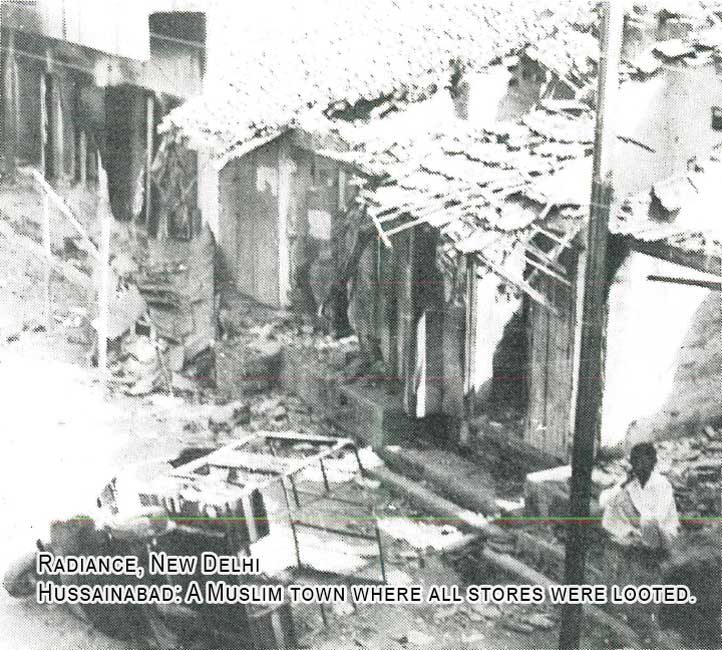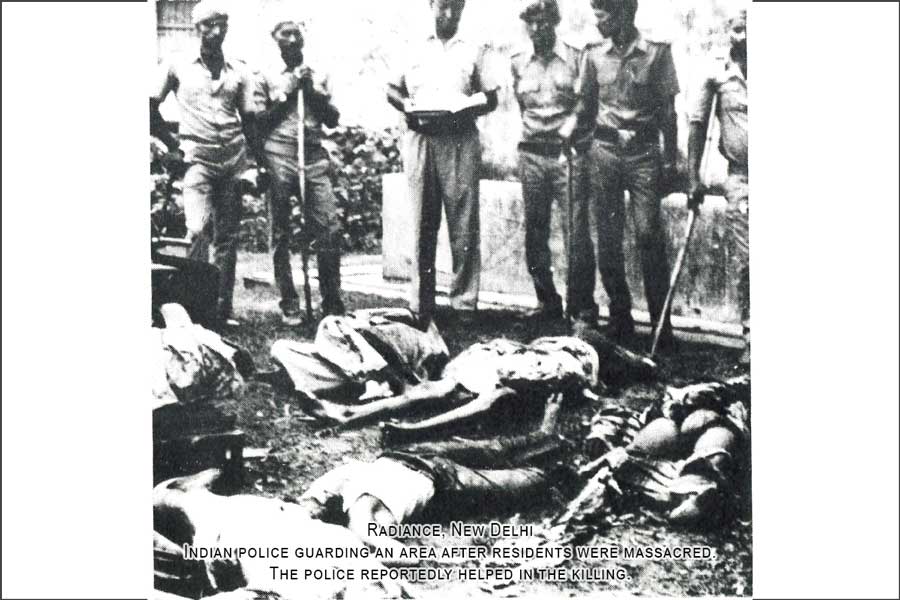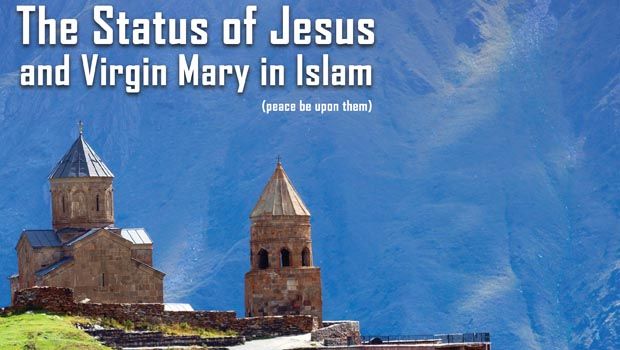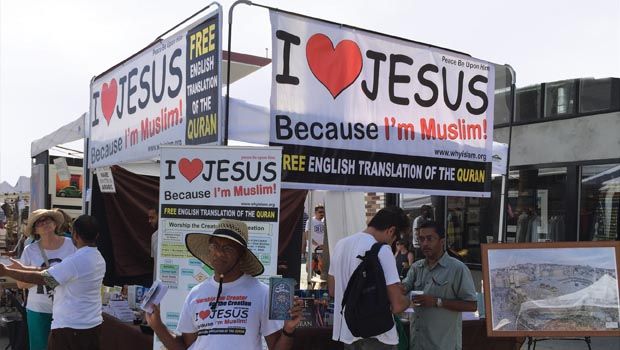• Over 1,500 Muslims massacred by Hindus.
• Official complicity in the genocide
• Coverup reported, full investigation unlikely.
Months after more than 1,500 Muslims were massacred in the Indian state of Bihar, New Delhi has grudgingly accepted the true magnitude of the tragedy it calls “communal riots.” For some strange reason, the American media, with its resources and knack for investigative reporting missed the Pulitz-er-Prize story in Bhagalpur District. The gory details of the Hindu savagery are gradually finding their way into the Indian and international newsrooms. In the aftermath, the world will be watching how India prosecutes those criminals and salvages its already-blotted human rights record. The following articles talk about the Bhagalpur carnage and the history of anti-Muslim and anti-minority violence in India.
The scars of communal holocaust may never be erased from the face of Bhagalpur, the once ever-humming silk town of northeastern India. Even three months after the Muslims of the town witnessed the state-spon-sored genocide, they appear shell-shocked. Stillness descends over the city much before the night sets in. The familiar whirl of looms has vanished from the city’s quarters where Muslim weav-ers once resided. Those who lost their near and dear ones in the October riots are still dazed. People talk about other communities in hushed tones as day after day discovery of mass graves makes macabre headlines. The burnt shells of houses, corpse-filled wells and ponds and ravaged habitations of Muslims are a living testimony to the magnitude of devastation that the area under-went.
Marauders of Bhagalpur have put even the killers of Meerut, Maliana and Hashimpura to shame. The strategy in Bhagalpur seems to have been three-pronged: physical liquidation, economic annihilation and administrative repression and alienation. The fact that the Bhagalpur Muslims were neither as help-less or resourceless as their Maliana or Meerut counterparts lent the tragedy vast dimensions. Yet what is clear from the benefit of hindsight available now is that the Hindu communal forces are ready to put on the fascist garb all through the Hindi-speaking states of north India. They have their sympathizers and supporters in the police, vernacular language press and the administration. The game plan is to charge the atmosphere with intense, virulent communal propaganda against Muslims, pick up issues that in-flame them and let the first violent spark fly from the Muslim side. The rest is all looked after by the bi-ased administration, partisan police and armed goons. The politicians usually have no option but to avoid accusing the Hindu chauvinists, lest they annoy the majority and put their public careers at stake.
From a distance the whole game plan of the Hindu fascist forces looks etched over the ashes of Bhagal-pur. The communal propaganda over the Babari Masjid had been built all across the Hindi-speaking states ever since the locks of the mosque were removed on February 1, 1986, under a court order. As the Rajiv Gandhi government in New Delhi appeased the upper-caste Hindu fascists, the Vishva Hindu Parishad, the Bharatiya Janata Party and the Rashtriya Swayamsevare Singh, had prepared the script for the 1989 electoral drama. Things were gradually pushed to a fiery crescendo on November 9, the date on which the first brick of the temple of hate was to be laid down at Ayodhaya, the sacred city for all faiths in India. But the bloody denouement reached at Bhagalpur decided the fate of the Gandhi gov-ernment, and the upper-caste Hindu champion, the BJP and its political accomplices carted away a good harvest out of the electoral battle. As if the warning signals sent by anti-Muslim violence in Badaun, Ko-ta, Indore, Sironj and Jaipur were not sufficient for the Gandhi government to heed, it dilly dallied to the question of propriety taking its place in the matter of Babari Masjid, which had a suit pending before the Allahabad High Court. Or perhaps the Mr. Gandhi had been waiting for a massacre of Muslims in order that the Hindu vote bank, raised by her slain mother, could tilt even more definitively in the Congress favor.
With the Hindu fascists game plan being clear, the Bhagalpur riots now look a meticulously executed plot. “Stoning of a Hindu procession” is a conventional excuse to explain the beginning of any Hindu-Muslim riot. So was it with Bhagalpur. Violence first broke out in Parbati and Tatarpur localities of Bhagalpur on October 24 after a Ramshila procession (procession carrying consecrated bricks for Ayodhyas’s proposed grandiose temple in the place of Babari Masjid) of the VHP was stoned by Muslims. The Muslims had earlier objected to the armed procession passing through their locality and demanded a detour which was possible. Reports indicate that the agent provocateurs had been posted by the local Con-gress(I) to hurl stones and bombs at the procession. The death toll reached 23 in the first two days of violence. The criminal gangs led by the notorious gangsters Yadava, Mandal and Gangotia, who operate on the river Ganges, used the opportunity to loot and burn the Muslim property. Trains passing through Bhagalpur became unsafe for Muslims as four Delhi bound passengers of Tinsukia Mail were dragged out and lynched between Bhagalpur and Jamalpur railway stations by riotous mobs. The army was called out on October 26 as the police had become accomplices of the rioters. The press reports indicate that the police abetted the heinous crimes of gangsters. The names of two officers, Arun Jha, District Magistrate and S.K. Dwivedi, Superintendent of Police, were mentioned in this context. When Mr. Dwivedi was transferred on the second day of the mayhem, the communally motivated police force openly threatened a revolt. The SP’s transfer was withdrawn by the administration on October 27 under the specious plea that it needed rewording. Informed sources have attributed the withdrawal of SP’s transfer to a verbal order from the Prime Minister himself. Several intellectuals have condemned the Prime Minister for the annulment of the order.
The district administration’s failure provided the marauders go to berserk for full three days which led to murders and ransacks in the localities of Champanager and Nathnagar, the two localities where poor silk weavers were killed, and their property was reduced to charred debris of looms. Among the killed were 37 members of five Muslim families of Naya Bazar Mohalla, including those of Faiyaz Bhagalpuri, the Youth Congress(I) leader of the district.
The army and Border Security Forces (BSF) were deployed immediately after the Prime Minister visited Bhagalpur on October 26. By then the police action against Muslims had spread into the rural areas around the town. The criminal gangsters resorted to massacre of helpless Muslims with the active sup-port of the local police. The ghastliest massacre of Muslims took place in Chanderi village, 10 kilometers from Bhagalpur, on October 27. It came to light only on November 2 when the army officer Major Gen-eral G.P.S. Virk found that a hundred persons were missing. He had put those people all Muslims, in the protection of the local police. It is said the victims were reported missing when Gen. Virk came back to the village to inquire about them. He found only three people alive and the place streaming with blood. A girl was thrown into the pond after her feet were chopped off. She was rescued by the army personnel. The army arrested 31 people, of whom 29 were hardened criminals. According to the Hindi Daily Janasatta (Delhi, October 29, 1989) a tractor full of corpses was seen heading for the River Ganges near Chandeli Village on October 28. The journalist who followed the tractor also noted the number plates of the jeep escorting the tractor (DPI-4707). The policemen in the jeep prevented the journalists from following the tractor. It is assumed the corpses were dumped into the river.

It is said the massacre took place on October 27 during the curfew relaxation hours between 11 a.m. and 4 p.m. Another report in the Telegraph, of Calcutta (November 3, 1989) said the police Super intendent Dwivedi had advanced information about the massacre but he neither went there nor rushed his forces. On October 26, immediately before the Prime Minister visited the town, gangsters attacked the Naya Bazar locality and killed 30 people and injured a hundred (all Muslims). It appears the Central. Re-serve Police Force (CRPF) helped the local police in beating and locking up people in the riot-torn areas. The Hindu, an English daily from Madras, (November 2) has quoted Dr. Kallimur Rah-man, Medical Officer of Bhagalpur University and Dr. M.A.I. Baig, Professor and Head of the Department of Botany, Marwari College, Bhagalpur, in this connection. Both had sought help from CRPF and were beaten and locked up in return. People were locked up in masse in police stations without any rhyme or reason. The partisan role of the local police, CRPF and Bihar Military Police (BMP) has been well established from the media coverage of the incidents. To the contrary, the role of BSF in checking the riots was noted by the newspapers. However, the state administration, acting in a highly biased manner, ordered the 23rd Company of the BSF, headed by Commandant Rajinder Singh, to vacate the town on November 4. Talking to newsmen, Commandant Singh said the riots were preplanned and the local administration had no intention to punish the guilty or probe into the causes of the riots. He said the BSF had found the well in Sanksrit College compound in Bhagalpur filled with corpses. They recovered 10 bodies and asked the local police to recover the rest. But the local police refused and instead poured DDT into the well to help early decomposition.
Such was the administration mood against the BSF that it asked Commandant Singh to vacate the room in circuit house by evening of November 4. According to Mr. Singh, all this was prompted by his warning to the local police to the effect that their unhelpful attitude would be brought to the notice of the Prime Minister.
The tales of police brutalities roam through the Muslim mohallas of Bhagalpur. Those who were killed will be forgotten soon. But those who survived will have to nurse their wounds. A glimpse into the hor-rendous accounts of their ordeal could be had from these interviews.
Haji Samiur Rahman, 75, with a fractured hand: “The police waltzed into my house by breaking the door. Abuses were hurled at me for the first few minutes. I was then dragged out of the house and kicked with boots and tossed. On my inquiring the reasons for this treatment, the reply I got was `Old Pakistani, you seem to be expert in bomb-making.’ More kicks followed. I was made to climb onto a truck. More kicks and slaps came as the truck moved. As it reached Kotwali (police station) I was pushed down with the knock of boots. We were driven into the lockup under a barrage of club-beating which fractured my hand.”
Mohammed Khateebur Rahman, 45, a local court clerk: “I was continuously beaten with rifle butts, el-bows, clubs and boots. Mercifully they spared me during our truck ride. But we were driven into a lock-up room which already had 250 people compressed within its narrow confines.”
Mohammed Shahabs Khan, government employee: “We were mercilessly beaten. When we asked why, the reply was, `because you are a Muslim.’ I heard the Superintendent of Police telling his colleagues: `They need not have been arrested. You should have brought their corpses.'”
Dr. Naseemul Haq, Professor, Post-Graduate Dept. of Physics, Bhagalpur University: ” I was arrested from my house in Basti Mohalla on October 25. The police entered the ground floor by breaking open the door. We had by then moved to the first floor. We pleaded with them that we are a dignified family. Nothing worked. They took me and my two sons, Ehtesham and Rehan, and herded us into the truck. We were beaten all along the route. Rehan, 15, was beaten so mercilessly that he fell unconscious. As the truck stopped near the Kotwali, everybody jumped under the raining lathis. We were stumbling and falling over each other while heading for the lockup.
Sometime later a police attendant called me by `Professor Sahib’ and took me to the District Magistrate. I was ushered into a room where the DM and SP were present. The conversation that followed was:
Q: Are you a professor?
A: Yes.
Q: What weapons do you have in your house?
A: Nothing, besides a knife for slicing vegetables.
Q: Swear by this book that you have no weapons in the house.
I swore while keeping my hands on the book.
But we cannot take your vow at face value. You are a professor. Per-haps you have never been beaten. So have the taste of beating today.’ From then on, I was ordered to be beaten and was beaten till I fell unconscious. They then dragged me into the lockup.”
Mithu Singh was arrested from a Muslim locality together with several Muslims. His was a case of mistaken identity as he appeared to be a Muslim. He had grown a beard and was wearing a kurta and pajamas.
He was continuously beaten despite his pleading with those police officers, that he was a Hindu. But the police would not believe him. “You deny being a Muslim just to avoid our lathis. We simply cannot spare you,” the constable would say.





